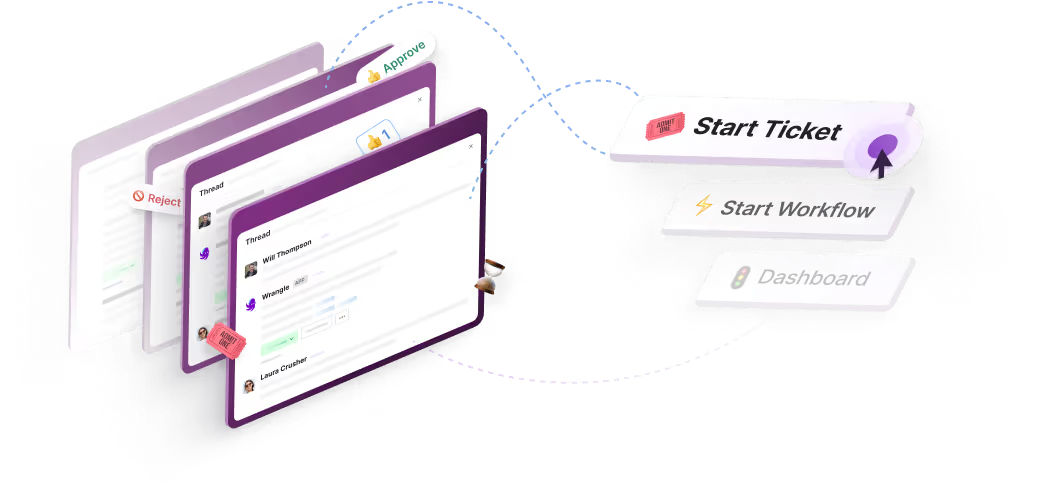10 Ticket Handling Best Practices and How to Implement Them
Understanding the best ticket handling process can help you gain optimal results for servicing tickets. Let's go over the top 10 practices.


When it comes to customer service, having an efficient ticketing system is critical for success. That’s because your ticketing system ultimately serves as the main line of communication between customers, vendors, and support agents.
An efficient ticketing process can make a small startup look like a large enterprise. At the same time, it can also make a large enterprise seem as approachable as a startup.
With this in mind, you can’t simply deploy an off-the-shelf ticketing system and hope for the best. Whether you use a third-party system or a DIY ticketing solution, it’s important to operate with best practices in mind.
Keep reading to learn more about what a ticket handling process is and how to achieve optimal results.
What Is a Ticket Handling Process?
A ticket handling process is a workflow for receiving, processing, and resolving service tickets. It applies to multiple business areas, such as customer service, IT support, and HR communications. All tickets—including account-related inquiries, cybersecurity questions, and HR requests—require careful handling and attention.
While ticket processes tend to differ between companies and teams, their ultimate objective remains the same: address the request and close the ticket.
Best Practices for Efficient Ticket Handling
It’s important to create a custom ticketing workflow that aligns with your specific business. As you begin crafting your ticket handling strategy, use the following best practices to guide your approach.
1. Use a Central Ticketing Platform
Companies typically use multiple communication channels like email, social media, text, and voice. Since customers reach out via their preferred method, all of these channels should flow into a central ticketing system for processing and escalation.
In other words, it’s beneficial to integrate multiple channels with a single repository for receiving, tracking, and responding to service requests instead of having messages go to different end users for triaging. This ensures a consistent and streamlined support strategy.
To centralize ticketing, you must first identify your communication channels and choose a suitable ticketing system. From there, you can create custom routing and categorization rules.
2. Factor in the User Experience
Ticketing systems aim to streamline ticketing requests and make life easier for support agents and specialists. As such, it helps to have a ticketing system that aligns with your team’s needs and preferences.
It’s also likely that some of your team members live with disabilities and may require special accommodations. As a best practice, select a ticketing platform that can integrate with technologies like screen readers, speech-to-text software, and tactile feedback devices to build a more accessible and inclusive environment.
To ensure your platform is a good fit, consider looping in your team members during the procurement process. Collect feedback to understand their specific needs and preferences to increase the chances that you select the right platform.
3. Standardize Ticket Tags
It’s necessary to assign all incoming tickets with tags—or categories—for efficient routing. When setting up a tagging system, consider standardizing the process and creating a single set of tags for the entire organization. This helps ensure the ticketing system processes and distributes tags accurately.
When setting up a ticketing system, you’ll want to work closely with individual departments to determine what specific tickets need. This way, you can avoid unnecessary tags and minimize confusion for end users.
Implementing ticket tags is fast and easy—and it's something you can do from any ticketing management system.
4. Determine a Hierarchy
Service tickets can be complex, requiring the attention of specialists and support teams. For this reason, it’s necessary to create a hierarchy for funneling and escalating tickets.
Having a hierarchy in place ensures that tickets go to the right individuals. This is important for resolving issues quickly.
When it comes time to determine a hierarchy, the first step is to categorize your ticket types. From there, you can link them to individual departments and team members.
5. Set Rules for Tickets With No Customer Response
Oftentimes, customers and end users who create tickets wind up disregarding them. People may forget about their requests or become too busy and move on. This is a problem for service desks, which need to minimize the number of open tickets.
The best way to handle this is to set policies for handling open tickets. For example, a company might notify a customer about an open ticket if they don’t hear back within a certain time frame. If the customer still doesn’t reply at that point, the ticket will close.
6. Create a Documentation Strategy
Documenting service tickets is necessary for a variety of reasons, such as performance analysis, historical reference, knowledge management, and continuous improvement. It may also be necessary for compliance—especially in highly regulated industries like healthcare and finance.
Most ticketing systems provide a framework for capturing essential ticketing data and making the ticket accessible. However, it’s also important to think about how your organization archives and stores tickets once they close. Some companies choose to keep tickets on-premises, while others use the cloud.
7. Benchmark Ticketing KPIs
Benchmarking ticketing performance is necessary to identify improvement areas. These benchmarks also provide justification and validation for critical resources.
To implement KPIs, you must determine which metrics are relevant to your operation. Some common examples of KPIs include ticket escalation rate, first contact resolution rate, and ticket backlog. Your ticketing management system should make it easy to track ticketing KPIs and generate reports.
8. Offer Self-Service Options
A growing number of companies are using self-service and automation technologies to improve ticket handling and reduce the burden on agents. For example, companies can use chatbots and self-help portals to provide speedy resolutions and help customers solve issues on their own. This reduces the volume of incoming tickets.
Just remember, there’s no substitute for live support. If your company decides to offer a self-help portal, let customers know they can message the company directly for advanced help.
9. Request Feedback From Customers and Vendors
Requesting stakeholder ticketing feedback is a great way to enhance the ticketing process and increase satisfaction. This shows customers, vendors, and employees that you care about improving the process and helping resolve their issues.
The easiest way to do this is to automatically send an email requesting feedback. Most companies choose to do this after the ticket closes.
Additionally, some organizations also choose to offer prizes and giveaways for participating. By incentivizing feedback, you can encourage participation.
10. Use Automation to Avoid Channel Babysitting
Many companies choose to use Slack for ticketing. While Slack is a great tool, it has one big drawback: users must sit in front of the platform and monitor incoming messages. This is time-consuming and pulls people away from other tasks.
The best way to fix this is to use an automation platform like Wrangle to automate Slack ticketing. Wrangle sends automatic notifications when messages come in and prevents incoming messages from falling through the cracks.
Start Using Wrangle Today!
In today's customer-obsessed world, it's more important than ever for companies to provide the best service possible in each interaction. For this reason, organizations must do everything they can to build an efficient ticketing process that helps customer service reps handle issues faster.
To this end, more and more teams are using automation to enhance the ticketing process. And with the help of Wrangle, your company can also leverage automation and optimize the ticketing process.
Wrangle can automate any Slack request for IT, sales, HR, customer success, and more. The platform integrates directly into Slack and features a no-code workflow builder, custom forms and approvals, and conditional logic for routing work.
Check out Wrangle by requesting a free demo or jumping in and adding the platform directly to Slack.
This post was written by Justin Reynolds. Justin is a freelance writer who enjoys telling stories about how technology, science, and creativity can help workers be more productive. In his spare time, he likes seeing or playing live music, hiking, and traveling.

- Try Wrangle free for 14 days
- Turn messages into trackable tickets
- Build a scalable help desk



Turn Slack into a productivity powerhouse with Wrangle
Create a scalable helpdesk in Slack. Automatically turn messages into trackable tickets and provide faster, more transparent service to your colleagues and customers with Wrangle — Try it free!






